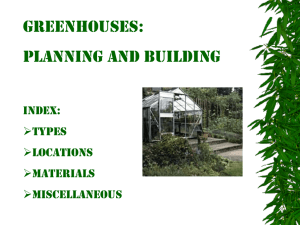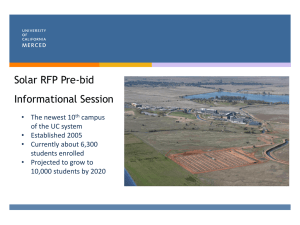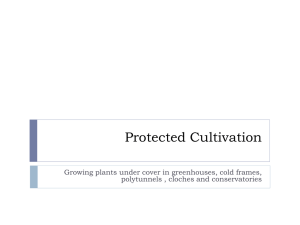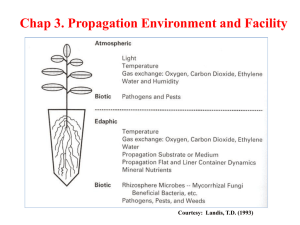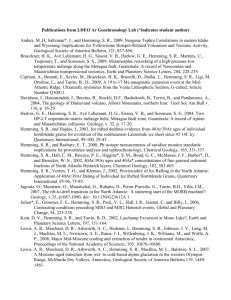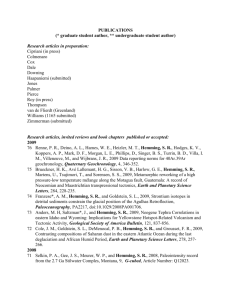Energy-efficiency
advertisement
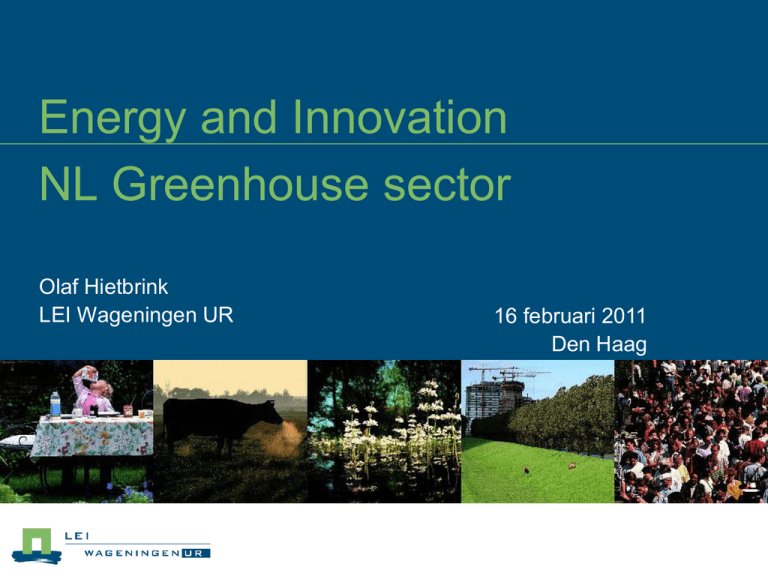
Energy and Innovation NL Greenhouse sector Olaf Hietbrink LEI Wageningen UR 16 februari 2011 Den Haag Content • • • • Trends towards the future Greenhouse horticulture NL Energy use en energy saving Horticulture and Innovation; energy as the driving factor • Entrepeneur is the key player Trends in agriculture Efficiency of scale: not only larger, also a second or third holding / location (even abroad), separated for technological / economic reasons Forward and backward integration: contracts, short chains, farm shops Diversification in agri niche markets (organic, nature contracts, agri-tourism, agri-healthcare etc.) Diversification outside agriculture: pluri-activity, investing capital elsewhere, including non-agricultural use of buildings, energy production Combinations of these trends Foresight(s) 2050 • Big issue: can we feed 9 billion (with higher income levels) with less environmental impacts? • The debate focus on scarcities: • • • • • • • Climate change Environmental impact and biodiversity loss Energy supply, biobased economy Phosphate supply Water availability Declining productivity growth Resistance to industrialisation of agriculture in Western countries Characteristics Dutch greenhouse sector Acreage 10,300 ha Vegetables Flowers Plants Seeds, cuttings, young plants 43% 28% 23% 6% Employment 50,000 – 60,000 people Turnover 6 Billion Euro (€ 60/m2) Export 80-90% Energy 4 billion m3 natural gas Energy: 20-30% of production costs Economies of scale increase quickly Modern Greenhouse holding Heat storage, energy production and glasshouses Energy targets covenants (sector and government) (1) Energy-efficiency (1990 = 100%) Energy-efficiency = primary fuel / unit production 2010 52% (-48%) 2020 43% (-57%) CO2-emission cultivation CO2-emission = fossil fuel Cultivation = exclusive selling electricity 2008-2012 6.6 Mtonne 2020 5.8 Mtonne Energy targets covenants (sector and government) (2) Share sustainable energy 2010 2020 4% 20% Cogeneration 2020 Reduction CO2-emissie national 2.3 Mtonne Capacity 3,000 MWe Running hours 3,500 / year Electricity production 10.5 billion kWh / year Energy Figures 2009 Consumption natural gas Netherlands = 46 billion m3 Consumption Greenhouse Sector = 3.9 billion m3 (8%) Cogeneration Greenhouse Sector = 3.2 billion m3 (8%) Electricity consumption Netherlands = 112 billion kWh Production cogeneration Greenhouses = 11 billion kWh (10%) Selling 6.2 billion kWh = 26% households Net selling 3.7 billion kWh = 15% households CO2-emission Netherlands = 174.5 Mtonne (2008) CO2-emission Greenhouse Industry = 7.0 Mtonne (4%) National reduction cogeneration Greenhouses = 2.3 Mtonne (1,3%) Energie efficiency 110 energye-efficiency (% 1980) 100 90 80 70 60 50 40 30 1990 1995 2000 2005 2010 2015 2020 year real development without cogeneration targets Physical production per m2 physical production (% 1980) 140 130 120 110 100 1990 1995 2000 year 2005 CO2-emission (Mtonne) CO2-emission 9,0 8,5 8,0 7,5 7,0 6,5 6,0 5,5 5,0 4,5 4,0 1990 1995 2000 2005 2010 2015 year CO2-emission total CO2-emission cultivation (excl. selling electricity) target cultivation 2008-2012 target cultivation 2020 2020 Sustainable energy share sustainable energy (%) 20 16 12 8 4 0 2000 2005 2010 2015 2020 year share sustainabble energy (%) target 2010 target 2020 Alternative Energy sources (2009) Efficient production Cogeneration growers 6,400 ha Buy heat (cogeneration other owners) 900 ha Buy external CO2 (enrichment crops) 0.5 Mtonne Sustainable energy Sun energy (closed greenhouses) 1.3% total energy consumption 187 ha Bio fuel (cogeneration and boilers growers) 66 ha Geothermal heat 15 ha Buy sustainable heat (bio fuel other owners) 33 ha Buy sustainable electricity (public grid) 91 million kWh Capacity Cogeneration Sector capacity cogeneration (MWe) 3500 3000 2500 2000 1500 1000 500 0 2000 2001 2002 2003 2004 2005 2006 2007 2008 2009 2010 beginning of the year Buy, sell and production Electricity: net supplier of electricity 12000 electricity (million kWh) 10000 8000 6000 4000 2000 0 2000 2001 2002 2003 2004 2005 2006 year buy sell production 2007 2008 2009 Gas price and net energy costs 260 240 index (2002 = 100) 220 200 180 160 140 120 100 80 2002 2003 2004 2005 2006 2007 2008 year commodity natural gas (cent/m3) net (buy - sell) energy costs (Euro/m2) 2009(v) Innovation: energy is a driving factor Programme Greenhouse as Energy Source Transition paths 1. 2. 3. 4. 5. 6. 7. 8. Solar energy / closed greenhouse Geothermal energy Bio-fuels Reduction demand Cogeneration Light (natural and artificial) External CO2 Energy grids Energy efficient greenhouses Steps: Maximum use of solar energy High light transmission of greenhouse (construction, covering, coatings, reduce screen use…) Reduction of energy use Efficient conversion of energy, heat storage and re-use Efficient energy use: unit product per unit energy Replace fossil by renewable energy bron: S. Hemming Energy efficient greenhouses Steps: Maximum use of solar energy Reduction of energy loss Winter: minimize energy loss (double AR glass, low-e coating, thermal screens…) Summer: efficient cooling (natural ventilation, fogging…) Efficient conversion of energy, heat storage and re-use Efficient energy use: unit product per unit energy Replace fossil by renewable energy bron: S. Hemming Energy efficient greenhouses Steps: Maximum use of solar energy Reduction of energy use Efficient conversion of energy, heat storage and re-use Co-generation, efficient conversion of solar energy, heat exchanger, heat storage and re-use Efficient energy use: unit product per unit energy goot Replace fossil by renewable energy bron: S. Hemming aanvoer in kas Energy efficient greenhouses Steps: Maximum use of solar energy Reduction of energy use Efficient conversion of energy, heat storage and re-use Efficient energy use: unit product per unit energy Temperature integration, no lower heating, higher humidity, reduced transpiration, intelligent climate control, new crop limits… Replace fossil by renewable energy bron: S. Hemming Energy efficient greenhouses Steps: Maximum use of solar energy Reduction of energy use Efficient conversion of energy, heat storage and re-use Efficient energy use: unit product per unit energy Replace fossil by renewable energy Biofuels, biogas, wood, solar cells, geothermal, wind…. bron: S. Hemming Climate controlled-energy efficient More conditioned greenhouses are the future control production factors high quality product, ready on demand economics of production Reduce energy consumption is demanded in the future maximum use of sun light reduce energy losses explore the limits of the crop use renewable energy sources Knowledge composition, innovation Experiments Research Extension Entrepe neur Capacity Building Government Education Entrepeneurial skills makes things happen Entrepeneurship essential for innovation and success (economic & sustainable production) Important factors for innovation : Intensity of production Energy market Markets & price development Consumer demand en societal impact Financial situation Thanks for your attention olaf.hietbrink@wur.nl www.lei.wur.nl © Wageningen UR


